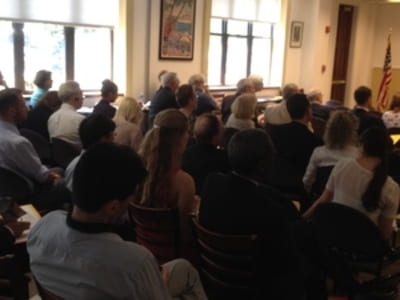WASHINGTON, D.C. – Singapore’s emergence from a tiny third world island nation to a first world power – with no natural resources and a population smaller than some U.S. cities – was the topic of discussion at a CCLP forum here on Monday.
Ashok Kumar Mirpuri, Singapore’s Ambassador to the United States, noted that decades ago, Singapore was dismissed as “a little red dot.” But what may have been intended as an insult became a term of pride, with “Little Red Dot” institutions sprouting through the country.

Ashok Kumar Mirpuri, Singapore’s Ambassador to the United States
“In 1965 Singapore was an independent with no resources of our own,” Mirpuri explained. Water and food were imported from Malaysia, and oil came from Indonesia. The priority back then, he said, was summed up in one word: “survival.”
Today, Singapore is a global business and transportation hub, with a world-leading airline, port and airport – the sixth-busiest in the world. GDP per capita has soared from US$500 to US$55,000 – yes, more than 100-fold.
And according to the Ambassador, it all began with two initiatives: education and business.
“We used education as a way to move people forward,” he said.
And indeed today, Singapore has two world-class universities, NUS and NTU, plus regional campuses in partnership with U.S. schools including MIT, Yale and Duke.
In business, for years Singapore has been at or near the top of global ratings as the best place in the world to do business, a longtime initiative of business diplomacy that has created the country’s economic foundation.
“There are more U.S. investments in Singapore than in China and India combined,” said Mirpuri, adding that half of the Fortune 500 have regional headquarters or research facilities on the island. One example: General Motors just moved its Asia headquarters from China to Singapore.
One major diplomatic initiative over the past five decades was to improve relations with Singapore’s neighbors, as the Ambassador put it, “to create a safe neighborhood around us.” Fifty years ago, ties to Indonesia were frayed. But today ties are so close that, according to Mirpuri, the Singapore-Jakarta air route is the second busiest in the world, with more than forty flights a day.
And 50 years ago, there were tensions between Singapore and Malaysia’s capital, Kuala Lumpur. That, too, has changed:
“The big target now is to create a high-speed rail link between the two capitals,” he said, to reduce travel time to two hours, “less than the Acela from Washington to New York.”
Asked how multicultural Singapore handles relationships with Muslim populations, the Ambassador noted his country’s frame of reference is very different from the U.S. or Europe, because Singapore’s neighbors are Malaysia, which is predominantly Muslim, and Indonesia, the largest Muslim country in the world. Rejecting one questioner’s phrase, “a clash of civilizations,” he said Singapore preferred to integrate its Muslim population and to reach out to embrace its Muslim neighbors.
Mirpuri was also asked about Singapore’s controls on media and free expression. He said all international media were readily available in his country – business could not function without it, he added – but that there were restrictions on what domestic media could do, to reduce ethnic tensions. And he compared it to similar practices in the U.S. that have similar objectives.
“We see Washington D.C. just banned some advertisements,” he noted, referring to the city’s ban last week on issue advertising in the DC transit system.
This CCLP Washington Communication Leadership program was part of a monthly series of lunch forums presented in partnership with the USC Center on Public Diplomacy and the Public Diplomacy Council.
The series continues through the summer. The topic for July’s forum will be “Boots and Beer, Hearts and Minds: Country Music as American Public Diplomacy.”
